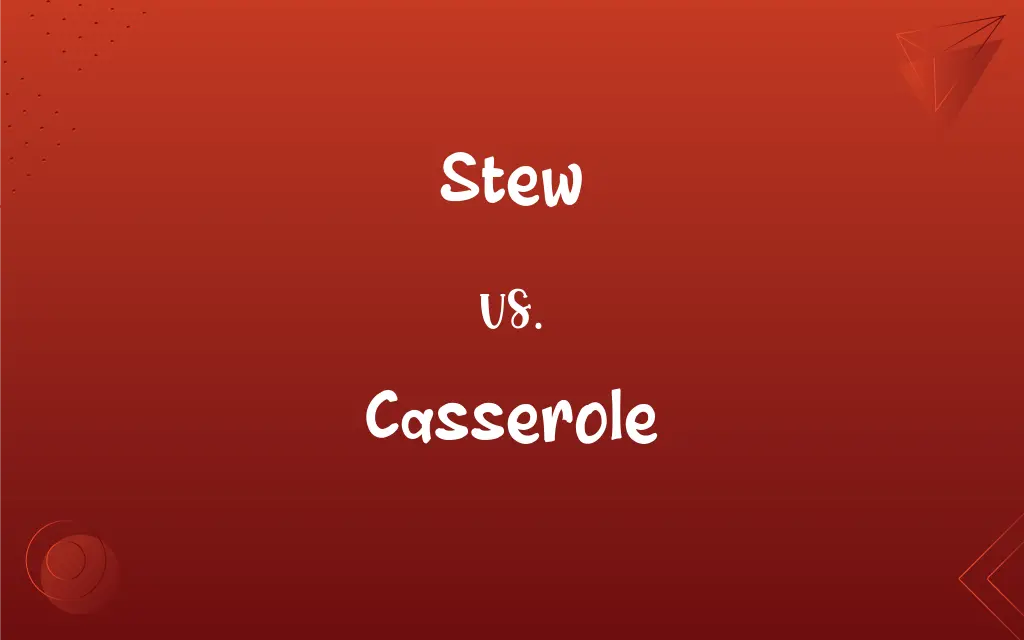Stew vs. Casserole: What's the Difference?
Edited by Janet White || By Harlon Moss || Updated on October 10, 2023
Stew involves slow-cooking small pieces of meat and vegetables in liquid, while a casserole is typically baked and may contain larger ingredients and a broader range of toppings.

Key Differences
A stew is a dish wherein meats, often paired with vegetables, are slow-cooked submerged in a liquid, often water, broth, or wine. On the other hand, a casserole refers to both a cooking method and the dish in which it is cooked and is usually baked in the oven. These cooking terms, while sometimes used interchangeably due to regional language differences, represent different culinary techniques and outcomes.
Stew, universally acclaimed for its ability to tenderize tougher cuts of meat, utilizes a gentle simmering process to extract flavors and meld them into a harmonious, often hearty dish. Comparatively, a casserole often assembles larger cuts of meat or other core ingredients, combining them with a starchy binder, vegetables, and a flavorful liquid that might coalesce into a gravy or sauce during the baking process. It's essential to note the engagement of distinct cooking techniques in stew and casserole preparation.
Stews can be found globally, from the Belgian “Carbonnade” to the Hungarian “Goulash”, symbolizing an amalgamation of available ingredients slow-cooked to perfection. Casseroles, meanwhile, might represent a layered or mixed approach to ingredients and can often be found capped with a crispy topping, such as breadcrumbs or cheese, providing an added textural component that you seldom find in a stew.
Differentiating stews and casseroles may sometimes hinge upon the vessel used for cooking. The word casserole originally refers to the deep, typically oval dish it is baked in. Stews are usually prepared in pots and are cooked on a stovetop. Yet, many modern recipes might blur the historical lines, showcasing the versatility and ongoing evolution within culinary arts.
The cultural and regional variances in stews and casseroles are markedly apparent, providing a tapestry of flavors and textures that depend on local ingredients, traditions, and individual twists. Both stews and casseroles can be found gracing tables across the world, delivering comfort, nourishment, and an ever-expanding array of delicious possibilities.
ADVERTISEMENT
Comparison Chart
Cooking Method
Slow-cooked, typically on a stovetop.
Baked, usually in an oven.
Cooking Vessel
Often cooked in pots.
Cooked in a deep, typically oval baking dish.
Ingredient Size
Generally involves smaller, evenly sized pieces.
Can involve larger, varied size of ingredients.
Textural Components
Tends to be uniformly soft and hearty.
May have varied textures, including crispy toppings.
Origin of the Word
Derived from the Old French “estuver”.
Comes from the French word “casse”, meaning case.
ADVERTISEMENT
Stew and Casserole Definitions
Stew
As a verb, to stew means to undergo cooking by boiling slowly.
Allow the mixture to stew gently for forty minutes.
Casserole
Casserole may suggest a social gathering where various such dishes are shared.
We're hosting a casserole night next Saturday for the neighborhood.
Stew
Stew might imply a mixture or assortment of various items or thoughts.
His mind was a stew of conflicting emotions and ideas.
Casserole
Casserole is a type of dish both used for cooking and serving.
She served the green bean casserole in a lovely, vintage dish.
Stew
In slang, a stew may refer to a flight attendant.
The stews on that airline are always so friendly and professional.
Casserole
As a food, a casserole involves varied ingredients baked together.
The tuna casserole was a hit at the family potluck dinner.
Stew
Stew is a dish of meat and vegetables slow-cooked together in liquid.
The beef stew simmered all day, filling the house with a savory aroma.
Casserole
Casserole can imply a method of cooking and baking ingredients together.
I will casserole the vegetables and chicken with a creamy sauce.
Stew
Stew can refer to a state of being worried or agitated.
She spent the night in a stew, anxious about the upcoming interview.
Casserole
In botany, casserole refers to a type of flowerpot or vessel for plants.
The orchids thrived in the decorative casserole on the patio.
FAQs
What is the essential cooking method for a stew?
A stew is typically slow-cooked, allowing its ingredients to simmer in a pot, often on a stovetop.
How is a casserole traditionally cooked?
A casserole is typically baked in an oven, often in a deep, wide dish that is also used for serving.
Can a stew be baked like a casserole?
While unconventional, a stew can be baked; however, it may lose its characteristic slow-simmered depth of flavor.
What kinds of meat are commonly used in stews?
Stews often feature tougher cuts of meat, like beef chuck or pork shoulder, that benefit from slow cooking.
What can I do if my casserole is too dry?
A dry casserole can be revitalized somewhat by adding a bit of broth, sauce, or a moist ingredient and reheating gently.
Can you cook a casserole on a stovetop like a stew?
Though typically baked, some casserole recipes might be adapted for stovetop cooking, with some alterations.
Can a casserole be made without a binding agent or sauce?
Yes, dry casseroles can be made, but a sauce or binding agent ensures cohesiveness and moisture in a typical casserole.
Can I use fish in a stew?
Yes, some stews feature fish or shellfish, such as bouillabaisse or chowder.
Can stews and casseroles be frozen?
Yes, both stews and casseroles generally freeze well, making them suitable for make-ahead meals.
Are there vegetarian casseroles?
Yes, casseroles can be vegetarian, featuring ingredients like beans, lentils, vegetables, and grains.
Can I make a stew without meat?
Absolutely, vegetarian and vegan stews can be made using vegetables, legumes, and meat alternatives.
Is it essential to seal a casserole while baking?
While not always mandatory, covering a casserole can retain moisture and prevent drying out during baking.
How can I thicken my stew?
Stews can be thickened using flour, cornstarch, or by reducing the liquid through extended cooking.
What liquids are typically used in a stew?
Stews often use broth, stock, wine, beer, or water as the simmering liquid.
Are there sweet casseroles?
Indeed, sweet casseroles, like bread pudding or sweet potato casserole, are popular in various cuisines.
Can I prepare a casserole ahead of time?
Absolutely, casseroles are often prepared ahead and baked just before serving, making them convenient.
How do I avoid my stew becoming too salty?
Add salt judiciously during cooking and utilize low-sodium broths or stocks to manage the stew’s salt level.
Can I make a casserole without cheese?
Certainly, while many casseroles feature cheese, it can be omitted or substituted depending on the recipe.
What distinguishes a casserole from a bake?
While similar, casseroles traditionally incorporate a moisture element like a sauce, whereas a bake might not.
How long should a stew be cooked?
Stew cooking times vary but generally require at least 1-2 hours to tenderize meat and meld flavors.
About Author
Written by
Harlon MossHarlon is a seasoned quality moderator and accomplished content writer for Difference Wiki. An alumnus of the prestigious University of California, he earned his degree in Computer Science. Leveraging his academic background, Harlon brings a meticulous and informed perspective to his work, ensuring content accuracy and excellence.
Edited by
Janet WhiteJanet White has been an esteemed writer and blogger for Difference Wiki. Holding a Master's degree in Science and Medical Journalism from the prestigious Boston University, she has consistently demonstrated her expertise and passion for her field. When she's not immersed in her work, Janet relishes her time exercising, delving into a good book, and cherishing moments with friends and family.































































